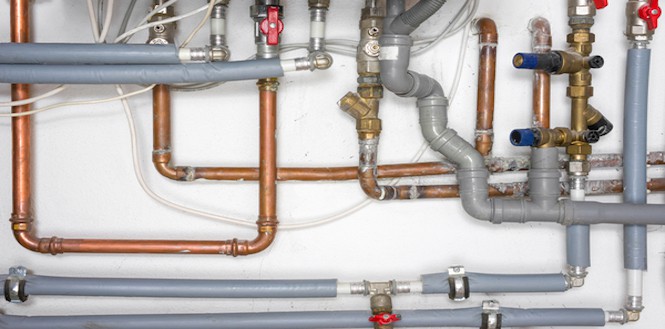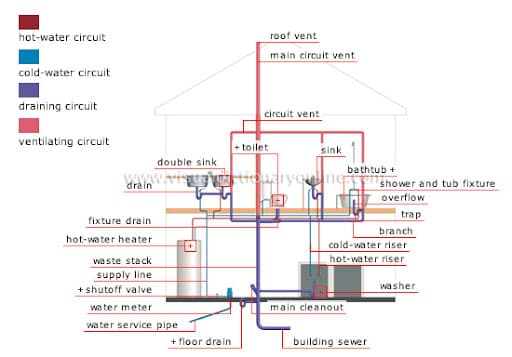Listed here underneath yow will discover a bunch of extremely good insights involving The Inner Workings of Your Home's Plumbing.

Comprehending how your home's pipes system functions is important for every single home owner. From supplying tidy water for drinking, food preparation, and showering to securely eliminating wastewater, a well-kept plumbing system is essential for your family's health and wellness and comfort. In this extensive guide, we'll explore the intricate network that comprises your home's plumbing and offer tips on upkeep, upgrades, and managing typical issues.
Introduction
Your home's pipes system is more than just a network of pipelines; it's an intricate system that guarantees you have access to tidy water and reliable wastewater elimination. Understanding its components and how they interact can assist you protect against expensive repair work and guarantee every little thing runs efficiently.
Basic Elements of a Pipes System
Pipelines and Tubing
At the heart of your pipes system are the pipes and tubes that bring water throughout your home. These can be made of various products such as copper, PVC, or PEX, each with its advantages in terms of resilience and cost-effectiveness.
Components: Sinks, Toilets, Showers, and so on.
Components like sinks, bathrooms, showers, and bathtubs are where water is made use of in your home. Recognizing exactly how these fixtures link to the plumbing system helps in detecting problems and intending upgrades.
Valves and Shut-off Points
Shutoffs manage the circulation of water in your plumbing system. Shut-off shutoffs are important during emergency situations or when you require to make repairs, enabling you to isolate parts of the system without interrupting water flow to the entire house.
Water System
Main Water Line
The major water line connects your home to the local water supply or an exclusive well. It's where water enters your home and is dispersed to various fixtures.
Water Meter and Pressure Regulator
The water meter procedures your water use, while a stress regulator makes sure that water moves at a secure stress throughout your home's plumbing system, stopping damages to pipelines and components.
Cold Water vs. Warm water Lines
Understanding the distinction between cold water lines, which supply water directly from the major, and warm water lines, which lug warmed water from the hot water heater, aids in repairing and preparing for upgrades.
Drain System
Drain Pipes and Traps
Drain pipes bring wastewater away from sinks, showers, and toilets to the drain or sewage-disposal tank. Catches prevent drain gases from entering your home and additionally catch particles that could trigger obstructions.
Air flow Pipes
Ventilation pipes permit air into the drainage system, stopping suction that can reduce water drainage and cause traps to vacant. Appropriate air flow is essential for maintaining the integrity of your plumbing system.
Importance of Proper Drain
Guaranteeing proper water drainage protects against back-ups and water damages. Regularly cleansing drains pipes and preserving traps can avoid costly repair services and prolong the life of your plumbing system.
Water Heating System
Types of Hot Water Heater
Hot water heater can be tankless or conventional tank-style. Tankless heating units heat water on demand, while containers keep heated water for immediate usage.
Exactly How Water Heaters Link to the Plumbing System
Understanding just how water heaters connect to both the cold water supply and warm water circulation lines assists in diagnosing issues like not enough hot water or leaks.
Maintenance Tips for Water Heaters
Regularly flushing your hot water heater to eliminate sediment, inspecting the temperature setups, and checking for leakages can prolong its lifespan and boost energy performance.
Typical Plumbing Problems
Leakages and Their Reasons
Leaks can take place because of maturing pipes, loosened fittings, or high water pressure. Attending to leaks without delay avoids water damages and mold development.
Clogs and Clogs
Clogs in drains pipes and toilets are usually triggered by purging non-flushable products or a buildup of oil and hair. Making use of drain screens and being mindful of what goes down your drains pipes can stop blockages.
Indicators of Pipes Issues to Expect
Low tide pressure, slow drains pipes, foul odors, or uncommonly high water bills are indicators of potential plumbing troubles that ought to be addressed without delay.
Plumbing Upkeep Tips
Normal Evaluations and Checks
Set up annual pipes inspections to capture issues early. Try to find indications of leakages, corrosion, or mineral build-up in faucets and showerheads.
Do It Yourself Maintenance Tasks
Simple jobs like cleaning faucet aerators, looking for bathroom leakages making use of dye tablet computers, or shielding subjected pipelines in cool climates can avoid major plumbing problems.
When to Call an Expert Plumbing Professional
Know when a plumbing problem needs professional proficiency. Trying intricate repair work without appropriate understanding can bring about even more damages and greater repair expenses.
Updating Your Plumbing System
Factors for Updating
Updating to water-efficient fixtures or replacing old pipelines can improve water quality, decrease water bills, and enhance the value of your home.
Modern Plumbing Technologies and Their Benefits
Explore innovations like wise leakage detectors, water-saving toilets, and energy-efficient water heaters that can conserve cash and lower ecological influence.
Price Considerations and ROI
Calculate the upfront costs versus long-term savings when considering plumbing upgrades. Numerous upgrades pay for themselves with lowered energy bills and fewer repair services.
Ecological Influence and Conservation
Water-Saving Components and Home Appliances
Installing low-flow faucets, showerheads, and bathrooms can substantially decrease water usage without compromising efficiency.
Tips for Reducing Water Use
Simple practices like fixing leaks immediately, taking much shorter showers, and running full tons of laundry and meals can conserve water and reduced your energy expenses.
Eco-Friendly Plumbing Options
Think about lasting plumbing materials like bamboo for flooring, which is durable and green, or recycled glass for countertops.
Emergency situation Readiness
Actions to Take During a Pipes Emergency situation
Know where your shut-off valves lie and exactly how to turn off the water supply in case of a ruptured pipe or significant leakage.
Significance of Having Emergency Situation Get In Touches With Convenient
Maintain get in touch with details for regional plumbing technicians or emergency solutions readily available for fast reaction throughout a plumbing situation.
DIY Emergency Fixes (When Applicable).
Short-lived repairs like using air duct tape to patch a dripping pipe or placing a pail under a dripping tap can reduce damages up until a professional plumbing professional gets here.
Verdict.
Comprehending the anatomy of your home's pipes system empowers you to preserve it effectively, saving money and time on repairs. By adhering to regular upkeep regimens and staying informed regarding modern plumbing modern technologies, you can ensure your pipes system runs effectively for years to find.
The Anatomy of Your Home s Plumbing System
Understanding the anatomy of your home s plumbing system is essential for any homeowner. It not only helps in identifying potential issues but also facilitates effective communication with professionals when repairs or upgrades are needed. Your home s plumbing system is more than just pipes and faucets; it s a complex network that ensures the efficient and hygienic flow of water in and out of your house. In this blog, we ll dissect the crucial components of your home s plumbing system. For those in Antelope Valley, Brock Plumbing is your trusted partner for all your plumbing needs, ensuring your system functions smoothly and efficiently.
Water Supply System
- Main Water Line: This is where your home s plumbing system begins. The main water line connects your home to the public water supply or a private well.
- Pipes and Shut-off Valves: Pipes distribute water throughout your home. Shut-off valves are crucial for controlling the flow of water and making repairs without shutting off the entire system.
Drainage System
- Drain Pipes: These pipes carry waste and water away from sinks, toilets, and showers.
- Vents: Vents allow sewer gases to escape and help maintain proper pressure in the drainage pipes, ensuring efficient flow of wastewater.
- Traps: Every fixture has a trap, a U-shaped pipe that holds water and prevents sewer gases from entering your home. The most common is the P-trap under sinks.
Fixtures and Appliances
Fixtures and appliances are the most interacted with parts of your plumbing system. They include sinks, toilets, showers, dishwashers, and washing machines. Each fixture and appliance has its own supply and drainage connection, ensuring they receive clean water and can dispose of wastewater effectively.
Water Heating System
Your water heater is a crucial component, providing hot water to various fixtures and appliances in your home. It can be tank-based or tankless, with each type having its own set of advantages and maintenance requirements. Regular maintenance is essential to ensure efficient operation and extend the lifespan of the unit.
Sump Pump
In areas prone to flooding or with high water tables, a sump pump is an essential part of the plumbing system. It s installed in the lowest part of your basement or crawlspace and pumps out water that accumulates, preventing flooding and protecting your home from water damage.
Septic System
Homes that are not connected to a municipal sewer system have a septic system and an underground wastewater treatment structure. Understanding how to maintain your septic system is crucial to prevent backups, odors, and early system failure.
Conclusion
Your home s plumbing system is a complex and essential network, ensuring the efficient and hygienic flow of water in and out of your property. Understanding its key components helps in maintaining it properly and identifying issues before they escalate into major problems. For residents in Antelope Valley, Brock Plumbing is dedicated to providing top-notch services, ensuring that every part of your plumbing system is in perfect working order. Trust our team of professionals to handle all your plumbing needs, ensuring your home remains comfortable, safe, and well-maintained.
https://brockplumbinganddrains.com/blog/the-anatomy-of-your-homes-plumbing-system/

As a keen reader on Plumbing Installation 101: All You Need to Know, I was thinking sharing that section was smart. Make sure you take the opportunity to share this blog posting if you enjoyed it. Thank you for going through it.
Call Today
Comments on “The Basics of Your Property's Plumbing System Anatomy”